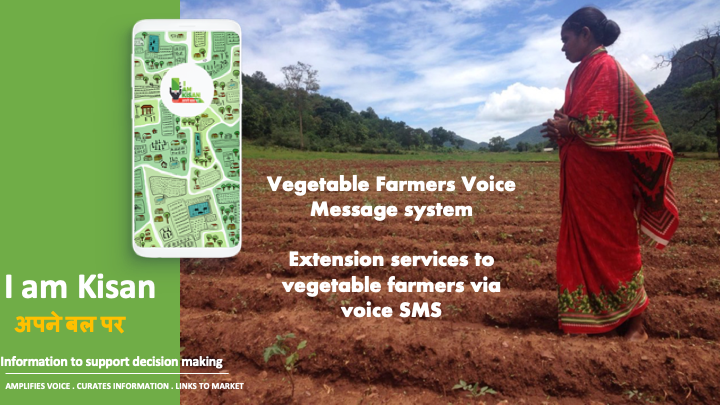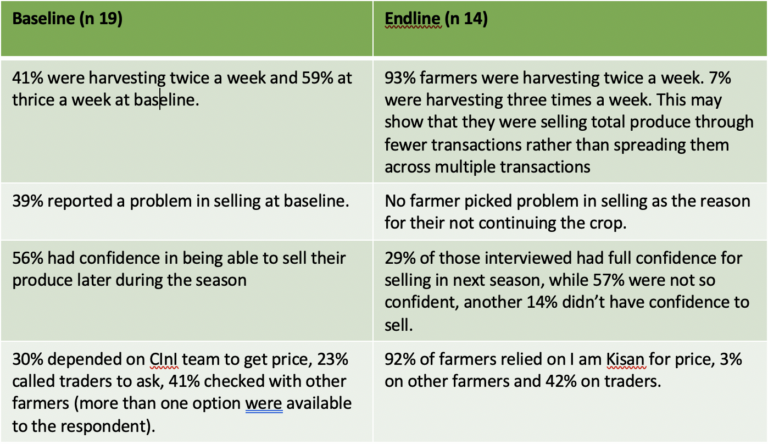Linkage with market is an essential one for vegetable farmers. For tribal farmers living away from highways and roads, a hassle-free fair marketing arrangement is one critical ingredient to their expanding their production effort.
We worked on one instance of use of technology in partnership with Collectives for Integrated Livelihood Initiatives to support farmers in Harichandanpur for market linkages. There were 80 farmers who were taking up bitter gourd cultivation. As the product requires regular picking for higher production and healthy crop, market linkages unlock more than just returns from higher price. It is further complicated because picking how much you can sell, still generates some regular cash return for the household. So, our goal was to create a network for farmers to be able to sell what they needed to sell for a healthy crop.
So our purpose became, Increased options for sale to farmers will ensure they realise optimal production of their crop. This will be reflected in duration of crop and total yield being
a) Crop lasts until November/December
b) Return is 8-10 quintals/week/acre
We started with a basic value proposition that “More options should be open to farmers for selling their produce at fair price and in hassle free manner”. We did not go in for “institutionalizing” marketing effort. We instead attempted to bring a connect with the live and local ecosystem of vegetable trading – but one where the farmer gets a fair price and is able to sell without too much hassle.
Result
Intervention 1: Voice call for disease alerts
We made an introductory call that introduced the program. We subsequently sent out voice messages on powdery mildew, sucking pests, fruit and shoot borer. We also developed three sutras or golden rules that would help farmers take longer crop. Usually, these messages had a response rate of 80% with all those who listened, listening in to about 80% or more of the message duration.

We shared the price of Barabati, Jajpur regularly via SMS. Later Bhadrak was added. Badbil was irregular. We also called farmers to find out the rate at which they were selling locally Calling farmers for price and circulation of the rate. This was shared with farmers with a focused message on price advisory – rate they could expect to sell at in their village. Mid way through the project, we changed the format of the message from just giving price information to giving a price advisory. This was a very critical change.
Intervention 3: Credible offers generated
This was initially built in to see that farmers were indeed able to sell to traders. We generated and linked up farmers with new traders to increase the footfall of trader in that area, to increase negotiation capacity of the farmers. The need for coordination mechanism was acute in this with high dependence on CInI team. Where we tried to directly coordinate with farmer, success was limited in terms of sale happening. However, there is reason to believe that they use the information to generate a better deal with the traders they are selling to. Revert of farmers on the deals offered is an area of improvement. Perhaps the process of this needs to be re-thought.
We did a quick survey over phone before and at the end of the intervention.

At endline…
92% farmers reported that they would take the crop again
For farmers who had done the crop previously (46% of sample), 87% reported higher yield, 62% reported better rate and 37% reported lesser disease load
8% farmers were in touch with 1 trader, 8% with 2, rest were in touch with 4 trader
While this data needs to be crosschecked, return ranges from 3,000 (Malati Tudu, 4 decimal) to 70,000 (Nabin Dandapat, 50 decimal) for farmers.
We also interviewed 37 farmers from villages towards Harichandanpur, similar socio-economic profile, who had not had the advantage of the price information. We found the following in this:
Of the 37 farmers who we reached out to, 54% had finished their crop by August-September after planting it in June/July.
There was evidence of high variation within the village (Jamuda, Madhyapur). Highest price reported by some farmers was 50% higher than that reported by others. The same experience is at the lower end i.e. lowest price received is almost 50% lower than the price received by others. Keeping planting period the same, this shows opportunity for better price discovery and connections within the existing eco system.
10/37 (27%) farmers whose crop was to finish by October got highest average price of 35/- with a modal value of 40. As rate during this period was more between 35-45, this shows again there was an opportunity for these farmers to have negotiated their price better.
33 of 37 farmers (89%) reported prices as low as Rs 10/-. Those who took early crop were more likely to have got this price and were connected with one or two traders alone. When told about the service of I am Kisan, they were keen to subscribe with their next crop cycle.
• Farmers tend to get into comfort zone with traders very quickly. Price message thus keeps them alert on what is going on.
• Even if they get the price information, their negotiation is limited to the offers available to them. This is where our generating credible offers makes it possible for them to”deploy” or actively use the price information.
• Farmers do not call us back – despite our constant reaching out to them. So, if the rate is sent, they will evaluate but not call us that they are not getting that rate. Orientation is important on how to use the price information.
• This project is best run in villages that are in the “leave- but-don’t-go-away” category of intervention. This means that the farmers know they have to build this linkage with the market
• Initiation of this project takes time with generating the phone numbers. The process needs to be thought through completely.
The success of this project is in the fact that 28 farmers from these villages paid a subscription fees to continue the service. It was continued into chilly crop.
I am Kisan now has more than 200 paying subscribers for its service, among first generation vegetable growers.
